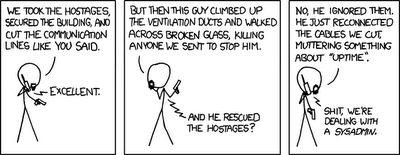I couldn't stop laughing...

Labels: fooling around
Curiosity is an everlasting flame that burns in everyone's mind... Curiosity is such a powerful force. Without it, we wouldn't be who we are today. Curiosity is the passion that drives us through our everyday lives. We have become explorers and scientists with our need to ask questions and to wonder. --Clara Ma, Elementary school student.
Labels: fooling around

Labels: fooling around
Labels: fooling around
Labels: fooling around, GUIs
Labels: fooling around, Windows XP Professional
Labels: fooling around
Labels: fooling around
Labels: fooling around

Labels: fooling around
Interviewer: Now comes the part of the interview where we ask a question to test your creative thinking ability. Don’t think too hard about it, just apply everyday common sense, and describe your reasoning process.
Here’s the question: Why are manhole covers round?
Feynman: They’re not. Some manhole covers are square. It’s true that there are SOME round ones, but I’ve seen square ones, and rectangular ones.
Interviewer: But just considering the round ones, why are they round?
Feynman: If we are just considering the round ones, then they are round by definition. That statement is a tautology.
Interviewer: I mean, why are there round ones at all? Is there some particular value to having round ones?
Feynman: Yes. Round covers are used when the hole they are covering up is also round. It’s simplest to cover a round hole with a round cover.
Interviewer: Can you think of a property of round covers that gives them an advantage over square ones?
Feynman: We have to look at what is under the cover to answer that question. The hole below the cover is round because a cylinder is the strongest shape against the compression of the earth around it. Also, the term “manhole” implies a passage big enough for a man, and a human being climbing down a ladder is roughly circular in cross-section. So a cylindrical pipe is the natural shape for manholes. The covers are simply the shape needed to cover up a cylinder.
Interviewer: Do you believe there is a safety issue? I mean, couldn’t square covers fall into the hole and hurt someone?
Feynman: Not likely. Square covers are sometimes used on prefabricated vaults where the access passage is also square. The cover is larger than the passage, and sits on a ledge that supports it along the entire perimeter. The covers are usually made of solid metal and are very heavy. Let’s assume a two-foot square opening and a ledge width of 1-1/2 inches. In order to get it to fall in, you would have to lift one side of the cover, then rotate it 30 degrees so that the cover would clear the ledge, and then tilt the cover up nearly 45 degrees from horizontal before the center of gravity would shift enough for it to fall in. Yes, it’s possible, but very unlikely. The people authorized to open manhole covers could easily be trained to do it safely. Applying common engineering sense, the shape of a manhole cover is entirely determined by the shape of the opening it is intended to cover.
Interviewer (troubled): Excuse me a moment; I have to discuss something with my management team. (Leaves room.)
(Interviewer returns after 10 minutes)
Interviewer: We are going to recommend you for immediate hiring into the marketing department.
Labels: fooling around